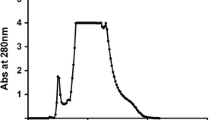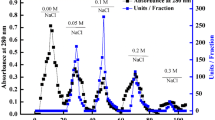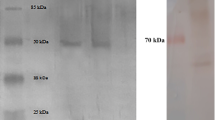Abstract
Peroxidase (EC 1.11.1.7; donor: hydrogen-peroxide oxidoreductase) catalyses the oxidation of various electron donor substrates (e.g. phenols, aromatic amines). In this study, the peroxidase was extracted from Thymbra spicata L. var. spicata and, then partially purified with (NH4)2SO4 precipitation and dialysis. The substrate specificity of peroxidase was investigated using 2,2′-azino-bis(3-ethylbenz-thiazoline-6-sulfonic acid) (ABTS), o-dianisidine, o-phenylenediamine, catechol and guaiacol as substrates. Furthermore, the effects of buffer concentration, pH, temperature and thermal inactivation on enzyme activity were also studied. The results obtained have shown that (i) the best substrate is o-dianisidine, followed by ABTS, catechol, guaiacol and o-phenylenediamine, respectively; (ii) the best buffer concentration is 40 mM for o-dianisidine and catechol, 10 mM for ABTS and guaiacol, and 100 mM for o-phenylenediamine; (iii) optimum pH is 2.5 for ABTS and o-phenylenediamine, 6.0 for o-dianisidine, and 7.0 for catechol and guaiacol; (iv) optimum temperature is 20 °C for catechol, 40 °C for ABTS, guaiacol and o-dianisidine, and 50 °C for o-phenylenediamine; and (v) the enzyme activity in the thermal inactivation experiments was enhanced with increase in temperature with o-dianisidine as a substrate while its activity decreased with o-phenylenediamine.





Similar content being viewed by others
References
Başer KHC (1993) Essential oils of Anatolian Labiatae: a profile. Acta Hortic 333:217–238
Sağdıç Ö, Özcan M (2004) Antibacterial activity of Turkish spice hydrosols. Food Control 14:141–143
Pizzale L, Bortolomeazzi R, Vichi S, Uberegger E, Conte LS (2002) Antioxidant activity of sage (Salvia officinalis and S. fruticosa) and oregano (Origanum onites and O. indercedens) extracts related to their phenolic compound content. J Sci Food Agric 82:1645–1651
Özcan M (1998) Inhibitory effects of spice extracts on the growth of Aspergillus parasiticus NRRL2999 strain. Zeitschrift fur Lebensmittel-Untersuchung und-Forschung A 207:253–255
Başer KHC (1994) Essential oils of Labiatae from Turkey: recent results. Lamiales Newslett 3:6–11
Doğan S, Doğan M, Arslan O (2003) Characterization of polyphenol oxidase from Thymus (Thymus longicaulis var. subisophyllus). Adv Food Sci 25(2):6–64
Aligiannis N, Kalpoutzakis E, Mitaku S, Chinou IB (2001) Composition and antimicrobial activity of the essential oils two Origanum species. J Agric Food Chem 49:4168–4170
Dorman HJD, Deans SG (2000) Antimicrobial agents from plants: antibacterial activity of plant volatile oils. J Appl Microbiol 88:308–316
Muller-Riebau FJ, Berger BM, Yegen O (1995) Chemical composition and fungitoxic properties to phytopathogenic fungi of essential oils of selected aromatic plants growing wild in Turkey. J Agric Food Chem 43:2262–2266
Doğan S, Doğan M, Arslan O (2003) Determination of some kinetic properties of polyphenol oxidase from Thymus (Thymus zygioides Griseb. var. lycaonicus (Čelak) Ronninger). Adv Food Sci 25(4):130–136
Lee CY, Whitaker JR (1995) Enzymatic browning and its prevention. American Chemical Society, Washington, DC
Whitaker JR (1985) Mechanism of oxidoreductase important in food component modification. In: Richardson T, Finley JW (eds) Chemical changes in food during processing. AVI Publishing, Westport, CT, pp 121–176
Richard-Forget FC, Gauillard FA (1997) Oxidation of chlorogenic acid, catechins, and 4-methylcatechol in model solutions by combinations of pear (Pyrus communis Cv. Williams) polyphenol oxidase and peroxidase: a possible involvement of peroxidase in enzymatic browning. J Agric Food Chem 45:2472–2476
Dowd PF, Herms DA, Berhow MA, Lagrimini LM (2000) Mechanisms of insect resistance in transgenic plants (over) expressing a tobacco anionic peroxidase. Plant Peroxidase Newslett 14:93–101
Tomas-Barberan F, Espin JC (2001) Phenolic compounds and related enzymes as determinants of quality in fruits and vegetables. J Sci Food Agric 81:853–876
Abdel-Aal ESM, Huel P, Sosulski FM, Graf R, Gillott C, Pietrzak L (2001) Screening spring wheat for midge resistence in relation to ferulic acid content. J Agric Food Chem 49:3559–3566
Matheis G, Whitaker JR (1984) Modification of proteins by polyphenol oxidase and peroxidase and their products. J Food Biochem 8:137–162
Leon JC, Alpeeva IS, Chubar TA, Galaev IY, Csoregi E, Sakharov IY (2002) Purification and substrate specificity of peroxidase from sweet potato tubers. Plant Sci 163:1011–1019
Fils B, Sauvage FX, Nicolas J (1985) Tomato peroxidases, purification and some properties. Sci Aliments 5(2):217–232
Geng Z, Rao KJ, Bassi AS, Gijzen M, Krishnamoorthy N (2001) Investigation of biocatalytic properties of soybean seed hull peroxidase. Catal Today 64:233–238
Vamos-Vigyazo L (1981) Polyphenoloxidase and peroxidase in fruits and vegetables. Crit Rev Food Sci Nutr 15:49–127
Whitaker JR (1994) Effect of pH on enzyme catalysed reactions. In: Principles of enzymology for the food science, 2nd edn. Marcel Dekker, New York, pp 271–300
Nicolas JJ, Richard-Forget F, Goupy P, Amiot MJ, Aubert S (1994) Enzymatic browning reactions in apple and apple products. Crit Rev Food Sci Nutr 34(2):109–157
Gonzalez EM, Ancos B, Cano MP (1999) Partial characterization of polyphenol oxidase activity in raspberry fruits. J Agric Food Chem 47:4068–4072
Marcos P, Martinez GA, Chaves AR, Anon MC (1995) Peroxidase from strawberry fruit (Fragaria ananassa Duch.): partial purification and determination of some properties. J Agric Food Chem 43:2596–2601
Kader F, Rovel B, Giardin M, Metche M (1997) Mechanism of growing in fresh highbush blueberry fruit (Vaccinium coryntosum L.). Role of blueberry polyphenol oxidase, chlorogenic acid and anthocyanins. J Sci Food Agric 74:31–34
Gonzalez EM, Ancos B, Cano MP (2000) Partial characterization of peroxidase and polyphenol oxidase activities in blackberry fruits. J Agric Food Chem 48:5459–5464
Cano P, Marin MA, Fuster C (1990) Effects of some thermal treatments on polyphenol oxidase and peroxidase activities of banana (Musa cavendishii, var. enana). J Sci Food Agric 51:223–231
Thomas RL, Jen JJ, Morr CV (1981) Changes in soluble and bound peroxidase-IAA oxidase during tomato fruit development. J Food Sci 47:158–161
Sakharov IY, Blanco MKV, Sakharova IV (2002) Substrate specificity of African oil palm tree peroxidase. Biochemistry (Moscow) 67(9):1043–1047
Sakharov IY, Ardila GB (1999) Variations of peroxidase activity in cocoa (Theobroma cacao L.) beans during their ripening, fermentation and drying. Food Chem 65:51–54
Zheng Z, Shetty K (2000) Azo dye-mediated regulation of total phenolics and peroxidase activity in Thyme (Thymus vulgaris L.) and rosemary (Rosmarinus officinalis L.) clonal lines. J Agric Food Chem 48:932–937
Wakamatsu K, Takahama U (1993) Changes in peroxidase activity and in peroxidase isoenzymes in carrot callus. Physiol Plant 88:167–171
Dicko HM, Hilhorst R, Gruppen H, Traore AS, Laane C, van Berkel WJH, Voragen AGJ (2002) Comparison of content in phenolic compounds, polyphenol oxidase, and peroxidase in grains of fifty sorghum varieties from burkina faso. J Agric Food Chem 50:3780–3788
Doğan S, Turan Y, Ertürk H, Arslan O (2005) Characterization and purification of polyphenol oxidase from artichoke (Cynara scolymus L.). J Agric Food Chem 53:776–785
Sakharov IY (2001) Biochemistry (Moscow) 66:515–519
Abelskov AK, Smith AT, Rasmussen CB, Dunford HB, Welinder KG (1995) pH-dependence and structural interpretation of the reactions of Coprinus cinereus peroxidase with hydrogen peroxide, ferulic acid, and 2,2′-azinobis(3-ethylbenzthiazoline-6-sulfonic acid). Biochemistry 34:4022–4029
Voet D, Voet JG (2003) Biochemistry. Wiley, USA
Kahn V (1977) Effects of proteins, proteinhydrolyzates and amino acids on o-dihydroxyphenolase activity of polyphenol oxidase of mushroom, avocado and banana. J Food Sci 50:111–119
Zhou H, Feng X (1991) Polyphenol oxidase from Yali pear (Pyrus bretschneiderl). J Sci Food Agric 57:307–313
Rocha AMCN, Pilar Cano M, Galeazzi MAM, Morais AMMB (1998) Characterization of “starking” apple polyphenol oxidase. J Sci Food Agric 77:527–534
Gazaryan IG, Reshetnikova MA, Doseeva VV, Bekker EG (1995) Biochemistry (Moscow) 60:767–772
Author information
Authors and Affiliations
Corresponding author
Rights and permissions
About this article
Cite this article
Doğan, S., Turan, P., Doğan, M. et al. Partial characterization of peroxidase from the leaves of thymbra plant (Thymbra spicata L. var. spicata). Eur Food Res Technol 225, 865–871 (2007). https://doi.org/10.1007/s00217-006-0493-8
Received:
Revised:
Accepted:
Published:
Issue Date:
DOI: https://doi.org/10.1007/s00217-006-0493-8




